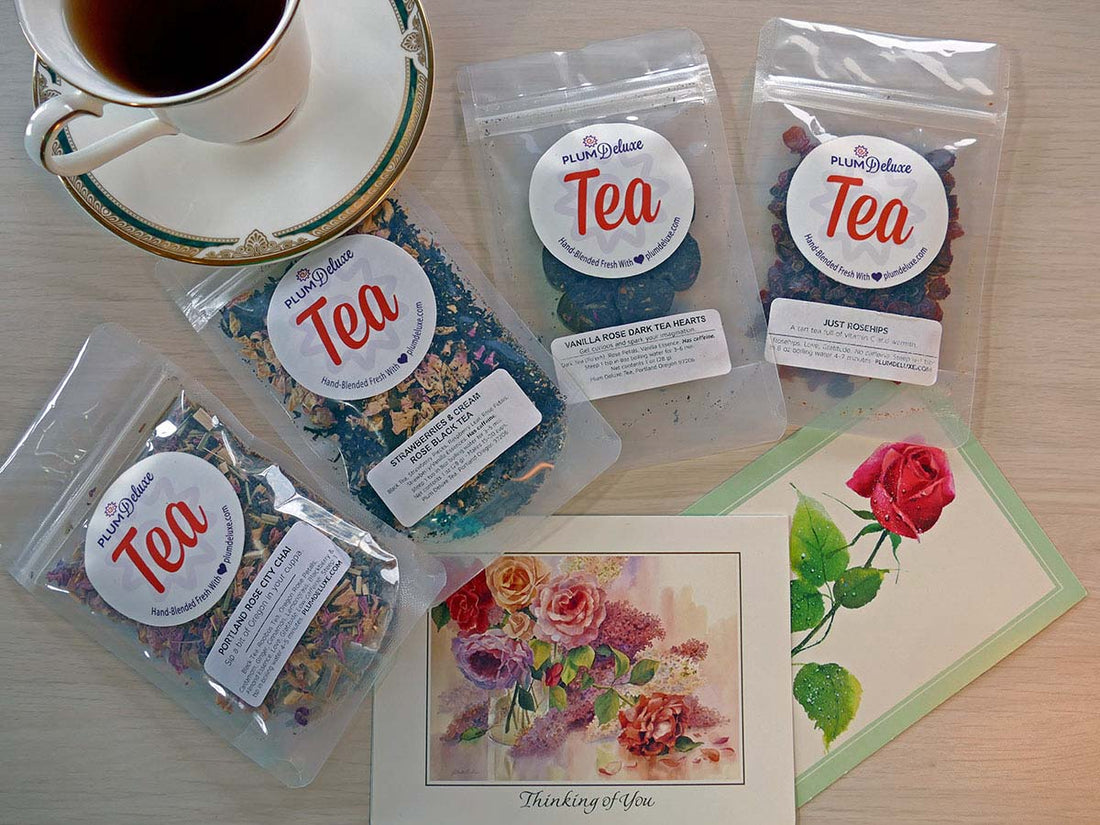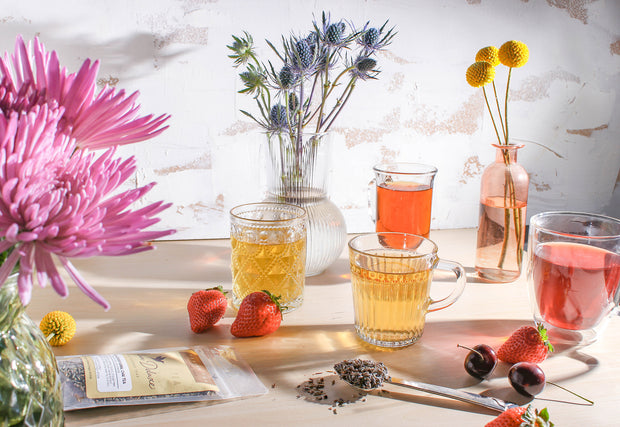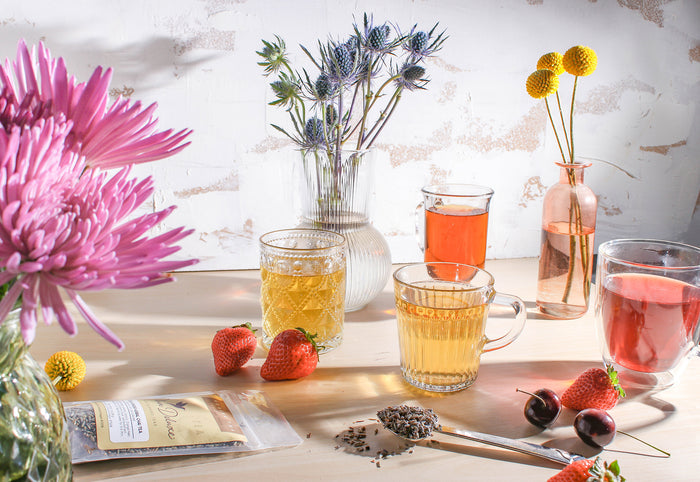A rose tea recipe might involve black tea with a splash of rosewater or fresh or dried rose petals steeped in water with a hint of sugar; or, petals blended with camellia sinensis leaves, or petals blended with an herbal tea base. Or rose tea may use rose hips instead of petals, by themselves or blended with leaves, herbs, and spices.
All that to say instructions for how to make rose tea vary. Widely. As do results.

Two Branches of the Rose Tea Story
Rose flavor is one of my things. I go to great lengths to obtain it, and I frequently play with it, in an unending search for the ultimate deliciousness.
Like people in the Middle East, India, and China, I enjoy aromatic rose petals in cakes, cookies, jams, syrups, extracts, soaps, candles, paper, and more. The delicate scent and flavor—oh, the feel of my hand in a bucket of downy-soft petals—both excites and soothes me.
In June, during the fleeting Alaska wild rose-blooming season, I collect buckets of petals to soak in water and vodka, to muddle with sugar, and to dry in the dehydrator. I have a yummy supply of frozen rose water, rose extract, rose sugar, rose syrup, and dried rose petals.
In September, I collect rose hips, the orange-red fruit those rose blossoms make. (When I pick petals in June, I leave two or three of the five petals on each flower so the flowers can still attract pollinators and make hips.) Packed with Vitamin C, rosehips make entirely different syrups, jellies, and teas.

Petals vs Hips: Both are used in Rose Tea Recipes
So, rose tea can be made with either rose petals or rose hips—or a combination. The taste, however, is enormously different.
Rose petal tea tastes like roses smell. It’s a delicate, subtle flavor, easily overwhelmed.
I confess I’ve had slim success blending petals with other tea flavors, but that doesn’t keep me from trying. Both fresh and dried petals can be tossed into the infuser with tea leaves and blends.
Some people find the flowery scent and flavor too much like potpourri, but I can’t get enough rose scent or flavor. Maybe I’m hard of tasting, at least where roses are concerned.
Tea made with rose hips tastes fruity, like plum butter and even pumpkin, with a tart leading edge. This sturdier flavor blends beautifully, and I don’t hesitate to toss Just Rosehips into fruity, citrusy, and chai teas. I take a deeper dive into rosehips in this article, so I’ll focus on rose petals here.

My Special Homemade Wild Rose Tea Recipe
My special homemade wild rose tea recipe starts with several hours wandering the hill out back to harvest rose petals, another hour or more sorting and cleaning them, soaking them in water for a day or two, then gently raising the temperature of that water to a light simmer until the pink color leaches from the petals to the water.
If you’re not so lucky as to have wild roses in your yard, you’ll have to add some time to cultivate a rose garden. Choose roses with a strong smell because when it comes to roses, fragrance equals flavor.
I may drink homemade rose tea with some rose sugar or honey, or I may steep some black or green tea leaves in it.
Homemade iced green-rose tea (i.e., green tea leaves steeped in freshly made rose water and sweetened with rose sugar) is a June treat I look forward to all year. Even better, though, is Garden Grove green tea, with an extra handful of fresh rose petals. Ohmygoodness, it’s tealicious!

Another Better-than-Homemade Rose Tea Recipe: Vanilla Rose Dark Tea Hearts
After seven-plus years of earnest rose petal collecting and experimentation, I would like to think I’ve perfected at least one rose tea recipe, but the truth is, I haven’t.
I’m not sure I knew this before joining the Plum Deluxe communitea, but it’s clear every time I brew a cup of soul-stirring heaven with Vanilla Rose Dark Tea Hearts.
This tea fascinates me. The flavor is . . . well, like deep cave roses. Imagine fragrant roses growing deep underground (yes, your imagination is the only place these roses grow).
There is a deep, earthy scent and taste with a distinctly rosy center. The rose is muffled by warm earth, but it is unmistakable, and gently assertive, as only a rose could be. It’s what I want to be in darkness.
Vanilla Rose Dark Tea Hearts are like no other tea I’ve had, carrying the fleeting seasonal rose essence into cold, dark winter.
I’m over the moon for Vanilla Rose tea and for Strawberries and Cream Rose black tea, which delivers on the promise of its name—and is available in the normal one-ounce size and a larger, four-ounce size because its fabulousness is not a secret.
But neither these nor Garden Grove with added rose petals is my favorite rose tea. (Gasp!)

How to Make Rose Tea (The Best Ever!)
I’ve acknowledged over and over that I can’t choose favorites, especially when presented with many excellent choices, but I do, in fact, have a favorite rose tea recipe.
It produces the best rose petal-flavored tea I’ve tasted. It’s better than the tea I make with a heap of fresh rose petals. Go figure.
Somehow, adding Camellia sinensis, rooibos, cardamom, ginger, cinnamon, lemongrass, blackberry, and almond does not smother the delicate rose flavor, but enhances it. I don’t understand the flavor chemistry at all; I just know Portland Rose City Chai is the best rose flavor I’ve ever had.
It's delightful on its own but can take a dash of cream. Or, for a delicious, creamy chai latte, you can mix it with equal parts tea and frothy milk, with honey to taste.

!['Chocoholic' Chocolate Tea Variety Pack [6-Pack Variety of Flavors]](http://www.plumdeluxe.com/cdn/shop/files/2.01-1800x1800-PlumDeluxe-DAJ-274695.jpg?v=1736886689&width=165)
![Patisserie Dessert Tea Variety Pack [6-Pack Variety of Flavors]](http://www.plumdeluxe.com/cdn/shop/files/4.01_-_1800_x_1800_-_Plum_Deluxe_-_DAJ_-_274695.jpg?v=1736886720&width=165)















